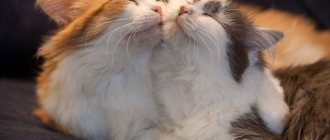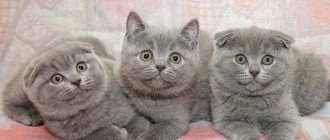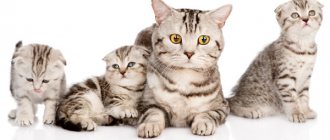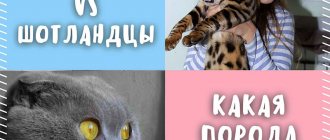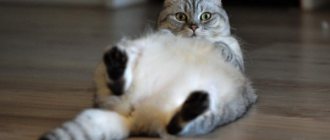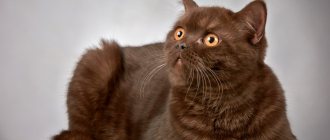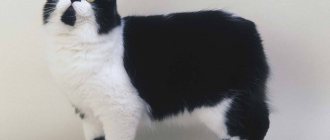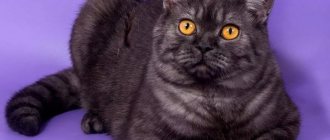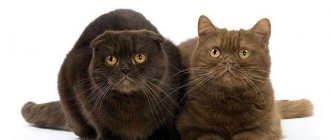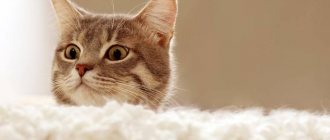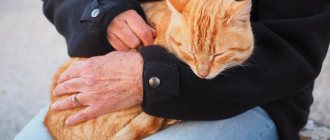The color of the eyes, skin and fur of the Scottish cat breed depends on melanin. This pigment is microscopic granules that fill the hairs. The concentration, size and shape of melanin vary.
The X chromosome is responsible for determining the sex of a cat and its coat color. Female cats have two X chromosomes. In males there is only one, the Y chromosome is present. The color of the future kitten depends on the location of the X and Y chromosomes. Therefore, the color of the fur of a cat and a cat may differ. For example, tortoiseshell coloring occurs mainly in cats. Cats get it in rare cases.
The color of the coat and eyes of future kittens is influenced by the pigment melanin . It consists of tiny microscopic granules that fill the cat's hair. The resulting color depends on the concentration of this pigment.
Melanin is divided into:
- eumelanin, which gives dark shades of wool;
- pheomelanin, responsible for light colors.
Explanation of the table: “M” is male, and “F” is female, “both” is typical for both male and female animals.
In addition to melanin, the X chromosome is responsible for coat color at the genetic level. It also affects the gender of the animal. A cat has a pair of X chromosomes, and a male has one adjacent to the Y chromosome. Due to this feature, identical colors may differ:
- tortoiseshell coloring is characteristic only of females; cats with this color can be born as an exception to the rule, but will be infertile;
- a blue-eyed white cat will be deaf.
Depending on the color of the parents, kittens may have a certain coat color. The shade will depend on the genotype that is inherent in the pair entering into mating .
The desired color largely determines the rules for selecting future parents:
Color
Peculiarities
Any partner is suitable for mating. If the descendants have deafness, then it is worth choosing a partner of a different color. The possibility of mosaicism (tortoiseshell shade) does not depend on the color of the parents.
Due to the non-dark color, the kitten will have a lightened undercoat. Mating with an animal of a color in which warm tones predominate leads to a reddish coat.
Warm purple and hot cream shades should be avoided. They give “rust” and clog the color.
Chocolate and lilac
When choosing partners, you need to focus on warm colors. Scots with bright red or cream shades without a “pattern” are suitable.
Red and cream
You need to avoid “patterns” on the fur. It is necessary to select pairs according to related color groups.
Unpredictable distribution of spots. The color is random.
You should choose a pair according to the uniformity of “smoke”. You cannot crossbreed with individuals of similar color.
Each animal carries in its genetic code 2 genes responsible for color. They are inherited from father and mother. Due to the predominance of certain genes, the following features are distinguished:
- when mating two white individuals with the W gene, a white WW baby is born;
- a recessive gene is always suppressed by a dominant one;
- an individual with the same type of genes is homozygous, and an individual with different types is heterozygous;
- if a white cat with a white coat is the owner of different genes, then she will give birth to kittens not only with snow-white fur, but also with others;
- the parent's pedigree determines the kitten's genetics
- matings of long-haired individuals cannot produce kittens with a short coat;
- parents of a dominant color will definitely produce the first offspring with the same color;
- if a kitten has one of the dominant colors, then at least one of the parents has the same one;
- two recessive partners cannot produce a baby with a dominant gene;
- a shaded cat can give birth to a smoky cub, but not vice versa.
Before mating, it is necessary to properly prepare future partners and create comfortable conditions. It is necessary to treat both the cat and the cat with due attention.
The female requires more care from her owner. First you need to prepare the animal.
There is no need to breed a cat after her first heat. This threatens complications and pathologies or the death of the offspring. A young cat may experience stress. The tartan will be ready for breeding after reaching one and a half years of age. It is best to choose day 3 or 4 of the third heat. Males are ready to mate at the tenth month. The animal is not at risk of disease even with early mating, which should be done in early spring due to increased fertility.
It is necessary to follow the rules for mating Scottish cats:
- Representatives of the same class cannot be mated. For a Scottish Fold cat, only a straight-eared male is suitable. The mating of two fold-eared animals leads to abnormalities and chronic diseases of the musculoskeletal function in the offspring.
- You shouldn't mix the Scots with the British.
- You need to choose a strong and healthy cat that is active.
- Don't experiment with colors. The result may be uneven color and eye color that stands out from the standards.
- The cat must be vaccinated.
- You should not wash your cat before breeding. The scent released will attract the cat.
- It is necessary to provide the pet with the most comfortable conditions possible.
- Leave the cats alone to get to know each other.
- Stop all attempts if one of the animals refuses the process.
The cat is capable of covering the kitty over ten times a day, but after a couple of days he loses interest in her. A cat can cover only one cat for fourteen days. If there are several cats for mating, then kittens can be born from each father.
There are other knitting features:
- If the female is larger than the male, then he should be helped with covering.
- To prevent the cat from falling to the side during mating, you should hold her.
- If there is aggression or fear on the part of one of the partners, mating should be stopped.
Due to stress when the environment changes, the cat stops estrus. In this case, you will need to bring it again. After mating, pregnancy may not occur. In this case, you need to leave the cat with the male for two days. After successful coverage, estrus may occur. When pregnancy occurs, the cat becomes calm and has an increased appetite. Fish should be removed from the diet (destroys B vitamins).
The future kitten is often used as payment for the provided male.
And a little about secrets.
The story of one of our readers, Irina Volodina:
I was especially distressed by my eyes, which were surrounded by large wrinkles, plus dark circles and puffiness. How to completely remove wrinkles and bags under the eyes? How to deal with swelling and redness? But nothing ages or rejuvenates a person more than his eyes.
But how to rejuvenate them? Plastic surgery? I found out - no less than 5 thousand dollars. Hardware procedures - photorejuvenation, gas-liquid peeling, radio lifting, laser facelift? A little more affordable - the course costs 1.5-2 thousand dollars. And when will you find time for all this? And it's still expensive. Especially now. Therefore, I chose a different method for myself.
Scottish cats have different colors. Scottish cats are famous because of their charming appearance and variety of colors. The color of kittens directly depends on certain genes. As a rule, these are two main shades, black and white.
Scottish Straight colors, for example, are gray with black stripes around the entire body. They are distributed as a percentage. That is, the animal’s fur is painted in two colors in different proportions. Its own gene is responsible for the dominance of one color or another.
Pregnancy
A cat's pregnancy lasts approximately 65 days. During this period, she has an increased appetite, sometimes nausea and vomiting in the morning, and walks are advisable for her. Your cat may want to eat something it hasn't eaten before, such as grass or carrots. There are special foods for pregnant and lactating cats.
A few days after the start of pregnancy, the cat stops calling to the cat by meowing and begins to look for a suitable place to give birth. The owner of the expectant mother should prepare a bedding or cardboard box in advance that is easy for the cat to enter and allow the cat to explore it.
In the fourth week, the cat's nipples turn pink and swell. During pregnancy, it is better not to pick up a cat in your arms, so as not to harm the unborn kittens. Kittens born before the 60th day are very weak and may die.
On the day of birth, the cat’s tail begins to get wet, it is worried, meows loudly, and may lose its appetite. A pale greenish mucous discharge appears from the vagina, which she often licks before giving birth. When the mucus plug comes out, pushing begins.
If you decide to give birth, that is, to make this process easier for the cat, then it is useful to know the following:
Pushing stimulation. Stroking the cat's stomach in the direction of the tail increases the pressure, if necessary.
Opening the shell. The kittens come out while in a transparent film. Breaking it will help the woman in labor.
Breathing stimulation. Lightly stroking the kitten along the spine stimulates breathing. He will clear his throat and start breathing.
Cutting the umbilical cord. The cat sometimes forgets to break it. To do this for her, you should tie the umbilical cord with a thread at a distance of 2 cm from the fetus, and then cut it 1 cm from the fetus.
Plain (solid)
The color of Scottish Fold cats is monochromatic and they should not have any other color. The fold-eared cat can be of the following colors: white and black, chocolate and lilac, blue and red, cream, fawn and cinnamon. The most popular color in the world among solid Scottish cats is blue. These are the majority of cats.
The white Scottish Straight cat can have different eyes, from blue and bright orange to rich amber and copper. Kittens of this variety remain white for the rest of their lives. If kittens have spots, then an adult cat remains white for the rest of its life.
The Scottish Fold black cat is mostly bright in color. A couple of white hairs are acceptable, but if the cat has large red and brown patches, then it is not a purebred.
Black Scottish Fold cats should be bright black in color and their ears, like all fold-eared cats, should be pressed to the head, unlike straight-eared cats. A straight-eared black cat always has its ears erect.
Chocolate
Scottish fold
chocolate looks impressive. The chocolate color is quite rare. Brown fold kittens should have a smooth, uniform coat of chocolate color. The dark brown coloring adds nobility to the cat.
A brown cat gets this color if he has chocolate, chocolate bicolor or chocolate color points in his pedigree. Chocolate Scottish kittens always delight their owners. They look very cool against a light background.
Lilac (lavender)
A lilac long-eared cat gets this color if he has either lilac color points or lilac in his pedigree. The lilac coloration goes well with orange, copper or amber colored eyes and a light brown nose. This color is also called coffee with milk.
Blue color (blue)
The Scots Blue can have a coat color of many shades of blue. Some cats may have a fur color closer to gray, and some closer to blue. Each hair must be saturated, then the coat will be perfectly blue.
Small pets have different patterns that disappear after a few months. Three months after birth, their eyes may be copper-colored.
Red (red)
Red Scots are a very rare breed. The ginger Scottish cat, like the ginger kitten, has a tail defect in the form of unevenly colored fur. In red-haired pets, red is sometimes more dominant than red.
These cats may have patterns on their foreheads and limbs, but this is not considered the norm. The Scots, unlike the British cat breed, can give birth to either a red fold-eared cat or a straight-eared cat.
The soft peach coat of a lighter color gives this cat an elegant appearance. At first glance, they are very similar to the red ones, but if you look closely, you can clearly see the difference. Cream hairs are lighter. Smooth patterns on the paws and tail are acceptable, but leopard spots are not acceptable.
Faun (deer)
The coat of kittens of this breed is a very interesting color. This shade should not be confused with lilac, which has a lilac tint. The paw pads and nose of these cats are beige-pink.
At first this color can be confused with chocolate, but this is not so. This look is lighter and softer. Its nose and pads are beige or pink-brown.
The coat color of these beautiful creatures has two colors, and a combination of white and any other shade is mandatory. Purebred bicolors must have a white belly, neck, chest, chin, limbs and, of course, muzzle.
Particolor (calico)
A Scottish cat of this type, called particolor, is a combination of white with tortoiseshell or spotted tabby color.
Harlequin captivated everyone with his unusual appearance. The cat is painted white (4/5 parts of the body), but the tail must be black, as well as the ears and the top of the head. The ventral part is white. The tip of the nose, like most people, is the same color - pink.
This breed only has colored tail, and sometimes has a few spots on the head. It happens that there are solid spots on the paws and back, but this is considered undesirable. When this breed develops red spots, it may also be called a Red Van.
Nurseries in Moscow, St. Petersburg and other large cities
Nurseries table
| City\ nursery | Breed type | felinological system | Color | Vet. vaccination passport deworming | Metric with pedigree | note |
| Moscow | ||||||
| LOVELY LAPATAN | Scottish Straight, Scottish Fold, Highland Straight and Highland Fold. | WCF | on golden or color point | available | available | Tray trained |
| SHEN-ALIN | Scottish Straight, Scottish Fold, Highland Straight and Highland Fold | WCF | golden, silver chinchilla shaded, ticked. | pedigree castration/sterilization of the animal | mixed food type | |
| MURKINO | Scottish Straight, Scottish Fold, Highland Straight and Highland Fold | WCF | gold or silver | available | receive a package of documents | |
| Saint Petersburg | ||||||
| Hathor Club. | Scottish fold | chocolate silver | available | receive a package of documents | ||
| BOLEMUR | Scottish Straight, Scottish Fold, Highland Straight and Highland Fold | WCF | gold or color point | available | package of documents | to professional food, tray, scratching posts |
| Kazan | ||||||
| MELODY SOUL | Scottish Straight, Scottish Fold, Highland Straight and Highland Fold | gold, silver, colorful. | Veterinary care | package of documents | super premium, holistic | |
| Ulyanovsk | ||||||
| Ulyanovsk cats | Scottish Straight, Scottish Fold, Highland Straight and Highland Fold. | ticked, gold, color-point | vaccinated | a pedigree is issued, but only after castration. | accustomed to all cat wisdom |
Vaccinations
At the age of 2.5-3 months, Scottish kittens are vaccinated. Before this procedure, at the request of the breeder, the baby is examined by a veterinarian and after diagnosis that he is healthy, he is prescribed:
- preventive deworming is carried out 7-10 days before;
- treat the fur against fleas with special preparations;
- Body temperature is measured;
- To vaccinate against major diseases, the Nobivac Triket vaccine is administered;
- A month later, the owner, using the same drug, repeats the vaccination.
- For a kitten who lives exclusively at home, the rabies vaccination is given later in the year, when the baby is stronger.
- All subsequent vaccinations are done annually with similar preliminary preparation.
- Kittens living outside the city in nature are recommended to be vaccinated against lichen.
Tortoiseshell
These animals have a lot of shades. This is mainly a tri-color color. Compared to other breeds, the tortoiseshell color does not have clear rules regarding the distribution of shades. The main thing is that they should be uniform.
Interestingly, only cats have a tortoiseshell color. Cats cannot be like this unless there is a genetic failure, but in this case they cannot have offspring.
This shade of coat appears due to the silver gene. The so-called Scottish Straight is black smoke. And they started calling it that due to the fact that it has a smoky color.
But today, smoky-colored Scottish cats do not have much confidence at exhibitions; they are not allowed there at all.
Color point
The Color Point is a rare breed of Scottish cat with a color similar to that of a Siamese cat. In childhood they look a little like Thai kittens. The main background is white or cream. The muzzle, ears, paws and tail are painted in darker shades. Color point or links point have blue eyes.
They acquired their colors from their British ancestors, who had Persians with this shade in their family. By the way, it is very difficult to distinguish a British cat from a Scottish one, and even professionals cannot always do this.
Who can this breed be crossed with?
In this breed there are cats and cats of two varieties: fold-eared - with curled ears and straight-eared - with erect ears.
Important: Throughout life, the ears of lop-eared dogs may straighten a little, while those of straight-eared dogs may bend slightly, but this does not in any way change the type of breed they belong to. In this regard, there are errors when indicating the breed in animal passports, and it is important to keep this in mind when choosing partners for mating.
Only fold-eared and straight-eared people can be confidently matched. In this case, the offspring will be genetically healthy. About half the kittens will be of the fold-eared variety, and half will be of the straight-eared variety.
It is risky to mix Scots with outbred cats, as well as with cats of any other breeds. The offspring can be either healthy or have health problems of varying severity.
You cannot reduce:
- Lop-eared with lop-eared. In this case, the defect in the cartilage tissue will affect not only the ears, and it will most likely be weak and sick. This will especially affect the limbs. Skeletal deformations, shortening of bones, thickening of joints, fusion of vertebrae are possible;
- Scots with British or exotics. The Scots have weak cartilage tissue, while the British have a heavy skeleton. When mating with Britons or exotics, kittens were born whose vertebrae fused in the future. The problems may turn out to be so serious that the only option left is to euthanize the animals.
Important: A Scottish Straight cat can easily be mistaken for a British Shorthair, which cannot be crossed with.
It is best if the cat is selected by the breeder from whom the cat was adopted. An experienced cat is more desirable than one that has never bred. It is correct to bring a cat to a cat, and not vice versa.
Tabby (tabby)
Tabby is one of the most popular cats among Scots. The color of Scottish tabby cats is distinguished by the presence of a pattern in a certain area on the coat. The pattern on the wool can be anything. A distinctive feature is considered to be a pattern in the form of the letter M on the forehead.
Tabby color depending on the type of pattern:
- striped like a tiger (has vertical stripes on the sides);
- spotted;
- marble (pattern of chaotic spots and stripes of different sizes).
And depending on the color combinations to the following:
- golden tabbies;
- cream tabby;
- blue;
- black marble;
- marble on silver
- silvery blue (gray tint);
- silver (silver color);
- cameo.
The Scottish chinchilla got its color from the British, and they, in turn, took this color from the Persians. The cat gets this color if the mother and father are chinchillas.
Chinchillas are divided into three types:
Solid colors of Scottish breeds
This group of colors is characterized by monotony, patterns, markings and ticking are absent.
Snow-white. The fur is iridescent, absolutely white. The eyes are the color of amber or heavenly. The standard also allows for different eye colors in an animal. The nose and pads are pinkish.
Black. The fur fully corresponds to the name, there is no red or grayish tint. The eyes are like amber, the nose and pads merge with the fur.
Blue. The edge is a cold dark gray shade. Eyes like amber. The nose and pads are the same color as the fur. See photo of Scottish Fold Blue cat.
Lilac. The fur is a warm soft gray shade, turning into cream. Eyes like amber. The nose and pads are in harmony with the fur (see all photos of the lilac Briton).
- Red. The edge is fiery. The eyes are like amber, the nose and pads match the color of the fur.
- Cream. The hair is light peach. Golden eyes, pinkish nose and pads.
Cinnamon, cinnamon color. Similar to milk chocolate. The nose and pads are pink-brown.
Scottish cat color chart
This is a tool with which you can recognize their rare species, and it is also important to take into account the rules for mating Scottish cats by color. This table is an international system for determining colors, which consists of numbers and letters.
Atlas of Scottish cat colors (open in full size)
Breeding kittens is not only a pleasant and troublesome activity, it is your contribution to increasing the population of these beautiful felines. Thanks to your participation, your cat will be able to live a full, healthy life, communicate with cats and raise her offspring.
Puberty in British cats occurs at approximately 8-10 months. However, the first mating should not be earlier than 1.3 years. This is the optimal age when the cat is ready physically and mentally. Mating cats at an early age can lead to difficult, protracted labor and death of offspring, and in males, to a shortening of the fertile period. Most often, British cats have their first heat and occurs after a year. A cat is not bred during her first heat. The ideal time for the first mating is the second or third heat.
The intervals between heats may vary depending on the breed of the animal and the time of year. Observations show that in purebred cats the number of estruses during the year can be much less than in ordinary domestic cats. The average duration of estrus is 4-6 days, but this period can be individual for each specific cat.
As a rule, the cat is taken to the cat (to his territory) on the 2nd day of estrus, since the most effective days for mating are days 3-4. On the first day, the couple is just getting acquainted, sniffing each other. During the day, the cat tends to its guest, “sings songs to her,” and the cat explores the new place.
If you want beautiful and healthy offspring, you need to carefully choose a partner for your pet.
You need to select a suitable breeding partner in advance. There are certain rules by which male cats are mated. They are established by the WCF (World Cat Federation) and must be followed to obtain high-quality breeding offspring that meet all breed parameters. Naturally, mating of British cats is permissible only between representatives of this breed, and to improve natural characteristics, select a partner of identical color (see color classification) or similar in classification. You shouldn’t improvise in this matter and mix, for example, silver and gold colors, or classic blue and lilac. Such unions often result in uneven coloration, and kittens with undefined eye color or tortoiseshell coloration will be difficult to realize, since most people choose a kitten primarily for aesthetic reasons.
Mating Scottish cats also has a number of specific rules. As you already know, this breed is divided into fold-eared and straight-eared representatives. Mating of fold-eared cats (Scottish Fold) is only permissible with straight-eared cats (Scottish Straight), and vice versa - if you have a fold-eared cat, then mating is only permissible with a Scottish Straight cat.
It often happens that pregnancy does not occur in the first mating! This is completely normal for a young, inexperienced cat, so don't worry and take her to the vet. Just wait until the next heat and take her to the cat again. For such a young cat, it is better to find an older and more experienced cat. For the most effective fertilization, the cat should spend 2-3 days with him.
A cat's pregnancy lasts for 9 weeks.
After mating, the cat becomes very calm and arrives in a peaceful state. The first signs of pregnancy can be determined only after 2-3 weeks by the color of the nipples; they turn pink and swell slightly, although this is not typical for adult cats (over 3 years old). During the first half of pregnancy, the cat begins to eat a lot, and its appetite noticeably increases. During this period, it is worth excluding fish from her diet because it destroys B vitamins necessary for fetal development. It is necessary to strengthen the diet with foods containing calcium: milk, sour cream, kefir, cottage cheese, yoghurts.
In the second half of pregnancy, at about 5 weeks, the belly begins to round and the cat noticeably gains weight. The second half of pregnancy always proceeds calmly, but be fully prepared by the end of the ninth week. By the time the kittens are born, you need to make certain preparations (see section on assistance during childbirth). When the birth is completed safely and all the kittens are warm next to their mother, be sure to praise your cat and pamper her with her favorite food.
When kittens turn 1.5 months old, they need to be activated in the club. You bring them to the club, where the color is recorded according to the corresponding number and a birth certificate (cat birth certificate) is issued. Get a veterinary passport for each kitten, write down the first anthelmintic treatment (see vaccinations).
Carrying out the procedure
Before mating, you need to be sure that neither the cat nor the cat suffers from any ailments. They should have no discharge from the nose or eyes, the coat should be in good condition, and the general health of the animals should be satisfactory. If one of the partners shows signs of weakness or illness, the mating should be postponed to a more favorable time. It is advisable not to interfere with the animals getting to know each other and sniffing, but it is still better to play it safe and be on the alert, since if they are incompatible, they can become aggressive and injure each other.
It may happen that pregnancy does not occur after mating, then she should be brought to the cat again. It is advisable to do this on the 2-3rd day of estrus and leave it with him for 2-3 days. Before the female stays, she needs to trim her claws so that she does not injure the cat if she does not like him in some way. During the day, a cat can cover a cat up to 15 times. But after 2 days, he ceases to be interested in his new partner. After mating, cats sometimes go into heat, but this does not mean that they are not covered.
It happens that the animals are not suitable for each other in size, and if the Fold cat is larger than the cat, then he will need to be helped so that he can cover the cat. Sometimes, due to a change of environment and severe stress, the cat stops estrus. Then she should be brought to the cat when it resumes. It happens that the cat falls to the side during the process, at such moments it is necessary to hold her in the right position for the mating to take place. If the female hides in a corner, behaves aggressively and the cat cannot approach her, then in this case she may remain untied.
Mating Scottish cats
In a Scottish cat, sexual activity begins at 7-9 months, but it is not recommended to mate such young animals. The optimal age for this is 1-1.5 years. Early mating of animals can lead to the most negative consequences, including infertility in the cat.
During the period of heat, the cat's behavior changes: it becomes affectionate, constantly rubs against the owner's legs, and rolls on the floor. If you run your hand along the cat’s back at this time, it bends, moves its hind legs, and throws its tail to the side. Cats often scream shrilly and unpleasantly. Sometimes cats have hidden signs of heat.
The Scottish cat breed is divided into straight-eared and fold-eared. The rules of the World Cat Federation stipulate that mating of straight-eared Scottish cats is possible only with fold-eared cats and vice versa. You should also not breed a male cat with a female cat, as the offspring may develop serious health problems, in particular, various disorders of the musculoskeletal system.
The same rules do not recommend mating British cats with Scottish cats, since in this case the kittens may be born with deviations from the breed standards. This can be seen in the shape of the kitten’s head, and the body can be much more massive than that of a real Scottish cat.
When you choose a cat for breeding, be sure to pay attention to its appearance, because this will determine what kind of kittens will be born. He should not have any discharge from his eyes or nose. Check the cat's body structure and coat quality. And also pay attention to the tail, since there are often Scots whose tail does not bend: these are all the consequences of the mating of two lop-eared individuals.
The first mating of a cat should be carried out during the third heat, skipping the first two
Source
Care and maintenance
The owner will have to devote a lot of time to caring for the furry pet.
Dogs' soft fur is prone to tangling and matting. If you do not take care of it properly, the dog will lose its attractiveness and will have a sloppy appearance.
- Comb them daily using a special slicker brush.
- Once every three to four months, the pet is bathed, choosing a shampoo designed for curly-haired dogs for water treatments. But in the groin area, face and paws of the pet you will have to wash every day, since in these places the fur gets dirty most often.
- It is recommended to trim your dog's hair at least once a month. If the owner is not sure that he can handle this, the haircut can be entrusted to a groomer.
- Bichons often have watery eyes, so they need to be cleaned regularly. Discharge from the eyes is removed with a cotton swab soaked in a special antiseptic solution. It is undesirable to use tea leaves or potassium permanganate for this purpose, as it colors the snow-white fur of dogs. It is also a good idea to periodically trim the fur around your pet’s eyes.
- Physical activity is not required and, if the dog is accustomed to relieve its natural needs in the tray, then it is not necessary to walk it every day. But the lapdog will be happy to accompany its owner on a walk.
These dogs love coziness and comfort, so it is necessary to purchase a soft lounger or house for the dog.
Feeding
https://youtube.com/watch?v=laQK6lXJkyg
Both dry food and natural food are suitable for feeding French lap dogs.
- Premium ready-made dry food contains all the ingredients curly-haired dogs need (meat, vegetables), vitamins and healthy additives, which is why experts recommend it for feeding.
- If the owner prefers natural food, then he should remember that the main food product for lap dogs should be lean raw meat, cut into small pieces. You can diversify your diet with fermented milk products, vegetables, porridge and boiled sea fish.
Mating, obtaining offspring
Animals that have received a breeding grade at an open class exhibition are allowed to breed, i.e. for a cat it is higher than “Very Good”, for a cat it is higher than “Excellent”. Animals with the titles “Champion” and above do not need to visit the breeding commission to receive a referral for mating.
When a cat begins to go into heat, it indicates that she has reached puberty; depending on genetic predisposition, this age can occur at 6 months or 10 months. They usually breed on the third heat, it does not depend on age.
All kittens resulting from such a mating carry the gene for folding ears and are considered Scottish (Scottish Straights and Scottish Folds). Some felinological organizations have prohibited interbreed matings between British and Scottish dogs (for example, in the WCF since 2004).
Scottish Folds are perhaps the most difficult breed to breed. If you cross two lop-eared individuals, the kittens may develop a number of defects, and there is a huge chance of being born disabled. There are, of course, exceptions and seemingly good kittens are born, but they can still carry defects that are initially invisible. All this is caused by the lop ear gene in both parents (Fd + Fd). Normal mating should be Fd + fd (fold + straight).
Ears can rise at any age, it depends on the genetic predisposition of each individual individual. Also, the ears can rise from stress, for example, in a cat during childbirth - the most typical case. Once the ears go up, they won't go down.
Proper and timely feeding is the key to good health and longevity of your pet. When choosing a diet, remember that a cat is a predator by nature, in...
Often, the cause of a particular disease can be determined only after laboratory tests.
Source
At what age to knit
A cat's first heat begins at the age of 5–6 months, depending on the environment, climate and nutrition. It may not be too noticeable. If you breed a cat at this age, it may have a bad effect on her young body and cause further infertility, and the offspring may not be viable.
It is best to skip the first 2 heats. The most favorable age for breeding a cat is from 1 to 1.5 years, when it reaches full physical development. If the female is not untied until the age of 1.5 years, then later, during the first mating, she will show significant resistance to the cat.
Before introducing animals, it is advisable to trim the cat’s claws in order to protect the cat in case of aggression towards him. You should also make sure that the female is in satisfactory health, in particular, check her for common infections:
Mating cats and female cats in Odessa
How to choose a cat for mating in Odessa
Cat mating is the process of breeding kittens by mating felines of the same breed. Such activities are very relevant for those people who strive to ensure the continuity of the breed for their domestic cats through the birth of new kittens. In addition, breeding kittens through mating cats can become a very profitable source of income if the kittens born are sold to people who want to have purebred cats.
In an effort to mate cats (females) with your pet, you should carefully select a partner, a cat for future mating. So, in addition to having the appropriate breed, the partner for mating must be in good health, without any diseases, so that the kittens born are not only distinguished by the continuity of the breed, but can also grow and develop successfully. In addition, in a situation where mating of cats is carried out for commercial purposes, it is desirable for the selected partner to have certain titles and awards, since in this case the born kitten will be especially highly valued by buyers.
When choosing a cat for mating, you should be guided by these listed criteria. And our bulletin board perfectly meets similar criteria, where, in the section dedicated to mating cats and males, the user always has the opportunity to choose the most suitable feline partner for his pet. We have a huge number of cats of various breeds, and their number is constantly growing
Source
COMPLICATIONS DURING MATING
Not all meetings go equally well. Sometimes a cat cannot get pregnant the first time - then you have to bring her to the same cat again and again. There is nothing strange about this, especially after the first mating.
Communication problems may also arise. The most common one is that the cat does not let the groom near. In this case, the owners should additionally excite her by stroking her in the area of the external genitalia, back and abdomen. Sometimes medical intervention is required: a probe is inserted into the vagina, after which mating occurs. Injections of drugs that induce ovulation are also given. But these are already extreme measures, which are worth taking only after weighing all the pros and cons. Most often, persistent but delicate behavior of the cat or a change of groom is simply required.
The opposite situation can also happen: the cat itself does not approach the cat. Perhaps he just didn’t like her, or maybe it was the color. If in early youth a cat was offended by some young lady, after that he may not approach females of the same color. Then, no matter how affectionate his new bride is, a similar color can disrupt the sexual mood. There is only one way out of this situation: select other partners.
Another common problem that we mentioned above is that the cat falls on its side during mating. Usually this position makes sexual intercourse impossible, but some cats can fertilize females on their sides. If this does not work, the person controlling the process must hold the cat so that it takes the correct position.
How to choose the right name for a Scottish kitten
The Scottish is a unique, incredibly beautiful and aristocratic breed of cat. These graceful animals have a calm and friendly character, they are sweet, playful and balanced. As you know, the name largely determines not only the character of the animal, but also its fate. Therefore, the name for a Scottish cat should be unusual, noble and sonorous.
Recommendations for choosing a nickname for a Scottish kitten
You can choose a nickname for the Scots based on the appearance or historical origin of the breed. But, before giving the kitten a name, it is advisable to observe its character and behavior for some time. After all, a name is not just a set of sounds. It should ideally suit the animal's temperament and appearance. You should not choose pretentious and unpronounceable nicknames for your baby. The pet is simply not able to remember them and will not respond to such a name.
If a kitten is purchased from a nursery, then the name given to it at birth will already be written in its passport and pedigree. As a rule, it must begin with a letter that is part of the parents' full names. Therefore, the kitten's name, written in the passport, can consist of three, four or even six words. Calling an animal such a full name is simply stupid, because the kitten will never remember it. In this case, you can use a shortened version or come up with a completely different nickname.
Choosing a nickname according to the origin of the breed
There is an opinion that the Scottish Fold breed was bred in Scotland back in the 19th century. However, the first official mention of this breed dates back to 1959. Interestingly, in addition to fold-eared cats, there is another variety - straight-eared Scottish cats (Scottish Straight).
Source
Scottish Fold (Scottish Fold cat)
For such representatives of the canine family, such as the Rottweiler, collie and Labrador, pug and fox terrier and many others, various forms of lop ears are not surprising, which cannot be said about cats. Fold cats, original in their kind, quickly won the attention of cat lovers. Thanks to this, the rather rare Scottish Fold has ceased to be a rarity, and has become not only very common, but also “reproduced”, which is something that lovers of purebred pets are somewhat unhappy about.
History of the Scottish Fold breed
In 1961, in Scotland, on one of the farms, a white cat, Susie, was born, who had unusual drooping ears, unique to her breed. Later it became known that this phenomenon occurred due to a spontaneous mutation. Subsequently, Susie became the ancestor of the current Scottish Fold cats.
By a stroke of luck for a unique, new breed, Susie became interested in breeder William Ross, who gave preference to British breeds. Oriental white fold cats with long hair were first mentioned in the 19th century, and then, a century later, one of these cats was allegedly brought to Britain from China.
William Ross and his wife Mary became the first authors of the current Scottish Fold breed and breeders. For this purpose they created the denisla nursery.
While Scottish Folds were few in number, their breeding program was based on mating them with outbred and shorthaired British cats. But the resulting kittens had bent ears rather than drooping ones.
Of course, in order to consolidate the new mutation in the Scottish Fold cat breed, representatives of two of them were mated
Source
Possible difficulties
Compliance with all of the above rules assumes the natural course of events. In normal condition, cats get along well with each other and will not cause trouble to their owners.
Minor deviations may occur in the following cases:
- One or both partners are taking part in mating for the first time - it will take them much longer to overcome the barrier of inexperience, but experts advise avoiding such pairings. The largest percentage of failures is in this situation.
- If one or both partners show aggression, it is recommended to introduce them at a distance (in cages or in a room separated by a net) and bring them together only when Scottish cats get used to each other.
- The owner of the apartment will have to keep the animals under control at all times and prevent them from causing mutual injuries.
- Females traditionally dominate males, and this creates difficulties when mating pets that are already familiar and live in the same territory.
- Additional problems can be caused by loud sounds, noise, the presence of strangers in the apartment and any other reasons that distract Scottish cats from mating and create a stressful situation for them.
If there is the slightest concern about the ability of the owners to independently organize crossing (or difficulties begin in the mating process), it is best to invite a specialist who will help the animals and monitor their condition.
Although rare, there are cases where Scottish fold cats cannot mate on their own and are left without offspring. It must be remembered that this breed does not have centuries of experience in survival and reproduction; it was created by people, and therefore, without their participation, it loses its independence.
